TAXIS
Hong Kong has 17,773 (at the end of 2024) licensed taxis, providing a personalised point-to-point public transport service. At the end of 2024 the average daily passenger patronage of licensed taxis was about 684,000.
Operating areas of taxis can be distinguished by colour of taxi, red (urban), green (New Territories) or blue (Lantau Island) with permitted operating areas being defined in Schedule 7 of the Road Traffic (Registration and Licencing of Vehicles) Regulations (Cap 374E).
TAXI FLEETS - From July 2025, following trials, the first five official licenced taxi fleets ("premium taxis") were authorised by the Transport Department to begin operation. See separate section "Taxi Fleets" further down page for information regarding taxi fleets.
URBAN (RED) TAXIS are available throughout Hong Kong including the airport and Disneyland (except for roads on the south side of Lantau Island and Tung Chung Road on Lantau which is open only to authorised vehicles). Taxis are currently not allowed to operate to Discovery Bay* (except Discovery Bay North) but previous restrictions on taxi access to Ma Wan were lifted on 14th December 2012 and urban taxis are since allowed access Ma Wan 24 hours a day.
* with effect from 26th October 2014 urban (and Lantau) taxis are allowed access to Discovery Bay North only, in the vicinity of Auberge Hotel, DB North Plaza and Yi Pak. The Discovery Bay Tunnel fee is waived for taxis. Taxis are not allowed access to other areas of Discovery Bay.
There were 15,020 licensed urban taxis at the end of 2024.
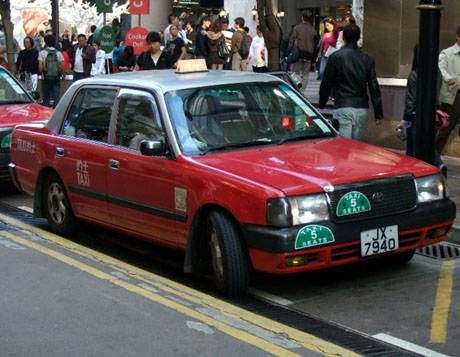
Red (urban) Toyota Comfort LPG taxi
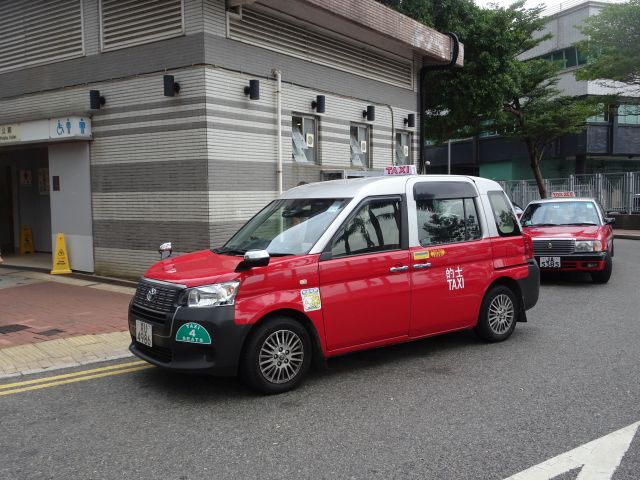
Toyota Comfort LPG/Electric Hybrid Urban Taxi introduced since early 2019
NEW TERRITORIES (GREEN) TAXIS are available in the following districts;
Tuen Mun
Tai Po
Yuen Long
New Territories North
Ma On Shan area of Sha Tin District
Part of Sai Kung District
They can also carry passengers along routes to the following specific locations;
Tsuen Wan MTR Station
Prince of Wales Hospital
Sha Tin Racecourse
Shun Lee Estate, Kwun Tong
Hong Kong International Airport
Disneyland
Tsing Yi Airport Express Station
Hang Hau MTR Station
There were 2,678 licensed New Territories taxis at the end of 2024.
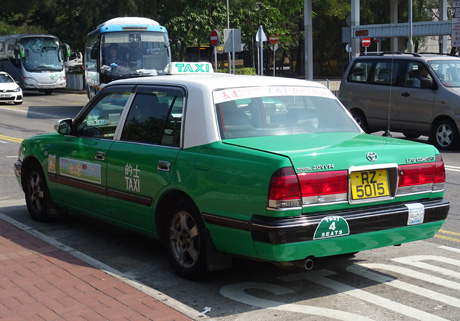
New Territories Toyota Comfort LPG Green Taxi
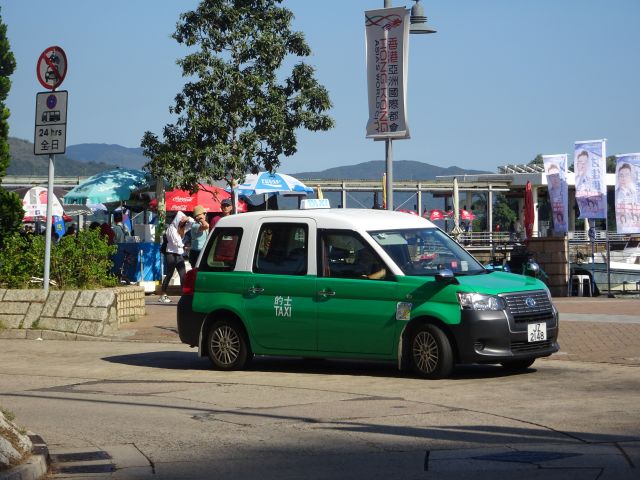
Toyota Comfort LPG/Electric New Territories Taxi
LANTAU ISLAND (BLUE) TAXIS are available on Lantau Island including Hong Kong International Airport and Disneyland but not Discovery Bay except Discovery Bay North*.
*With effect from 26th October 2014 Lantau (and urban) taxis are allowed access to Discovery Bay North only, in the vicinity of Auberge Hotel, DB North Plaza and Yi Pak. Taxis are not allowed access to other areas of Discovery Bay. The Discovery Bay Tunnel toll fee is waived for taxis.
There were 75 licensed Lantau taxis at the end of 2024. The number of Lantau taxis had previously been restricted to 50 until the government invited tenders for an additional 25 Lantau taxis in December 2015.
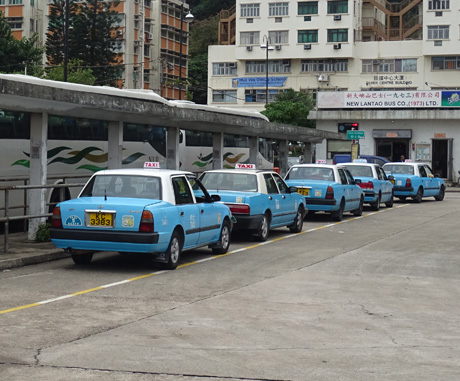
Lantau Blue Toyota Comfort LPG Taxis at Mui Wo Ferry Pier Public Transport Interchange
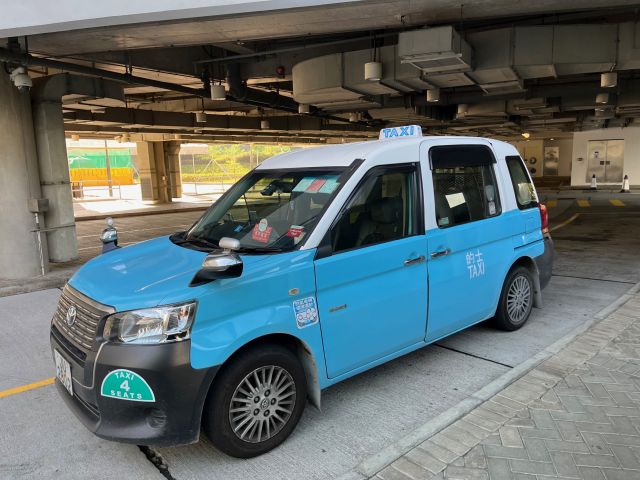
Toyota Comfort LPG/Electric Hybrid Lantau Taxi
TAXI FLEETS - From July 2025, following trials, the first five official licenced taxi fleets ("premium taxis") were authorised by the Transport Department to begin operation. SEE SEPARATE SECTION FURTHER DOWN PAGE FOR DETAILED INFORMATION REGARDING TAXI FLEETS.
The colour coding system for taxis was introduced by the Transport Department in the 1970's in order to distinguish legitimate taxis from illegal taxis. The colour scheme of red for the lower half and silver for the upper half of urban taxis was unveiled in September 1974. After the Cross-Harbour Tunnel opened in October 1974, distinct separate colour schemes for Hong Kong Island and Kowloon taxis were proposed as it had become apparent that some taxi drivers on Hong Kong Island were unfamiliar with roads in Kowloon and vice-versa but these plans were rejected. However, although able to operate in the New Territories drivers tended to congregate in Kowloon where demand was higher and illegal taxis continued to operate. In June 1976 a New Territories taxi service was introduced with a green and silver colour scheme. Urban (red and silver) taxis were allowed to continue to operate into the New Territories in order to prevent a situation where taxis had to change taxis at the boundary but New Territories taxis are not allowed to operate in urban areas. The colour coding of taxi operating areas continued when the 20 first blue/silver taxis serving Lantau Island were introduced in 1983. During the 1980's and early 1990's there was a large increase in demand for taxis as Hong Kong's growing prosperity made them more affordable but the subsequent increase in road space occupied by taxis made them a major cause of congestion and in 1994 the government decided to stop issuing new licences in order to constrain supply. Since 1994 no new licences were issued until mid-2016 when 25 new licences were awarded for blue Lantau taxis.
At the end of 2020 there were 203,027 people holding a taxi full driving licence, broken down by age groups;
29 or below 1,312
30-39 8,851
40-49 20,683
50-59 60,118
60-69 87,412
70-79 23,207
80 or over 1,444
TOTAL 203,027
There were 206,884 taxi full driving licence holders at the end of 2023.
There were 210,030 taxi full driving licence holders at the end of 2024.
The average daily patronage of taxis during 2023 was about 729,500.
In comparison to most other major cities, fares are modest and did not increase between 1998 and 2007. However, in February 2008 a modest one HK dollar rise in flagfall for Urban and New Territories taxis was applied. Following a review of taxi fares and applications for increases from taxi operators associations the government approved further fare adjustments for urban and Lantau taxis which took effect on 30th November 2008 and a new fare structure for New Territories taxis took effect on 16th January 2009. Further increases took effect on 10th July 2011 when the flagfall for all taxi fares increased by HK$2 to HK$20 for urban taxis, HK$16.5 for New Territories taxis and HK$15 for Lantau taxis. Owing to continuing rising fuel and maintenance costs, proposals for further increases were approved and took effect on 8th December 2013 when the flagfall for the first 2km of each journey increased by a further HK$2 to HK$22 for urban taxis, HK$18.5 for New Territories taxis and HK$17 for Lantau taxis. Additionally, the first stage incremental charge for each 200-metres after the flagfall to was increased by ten cents to HK$1.6 red taxi (journeys 2-9km), HK$1.4 green taxi (journeys 2-8km) and HK$1.4 blue taxi (journeys 2-20km). The surcharge for green taxis for each piece of baggage, animal or bird, and telephone booking, was increased by HK$1 to HK$5, bringing it in line with red and blue taxis.
In February 2017 taxi fare increases were approved which took effect from 9th April 2017, The flagfall charge for the first 2km of any journey increased by HK$2 and the first-tier and second-tier incremental charges in respect of each subsequent 200-metres travelled increased by HK$0.1 and HK$0.2 respectively. Charges for waiting time after the initial flagfall increased in line with the incremental first-tier and second-tier charges and the luggage charge per piece (except light luggage carried inside the passenger compartment) increased by HK$1. The government has estimated that the average increase is 9.98% for Urban taxis, 11.5% for New Territories taxis and 8.6% for Lantau taxis. The increases are less than requested by the taxi trade in its application In late 2016 when representatives applied for an increase in flagfall of HK$2 to HK$24 for the first 2km of each journey for urban taxis, a HK$2.5 increase in flagfall to HK$21 for New Territories taxis and HK$4 increase to HK$21 for Lantau taxis plus an increase in the charge for every 200-metres after the first 2km of 20 cents to HK$1.8 for urban taxis and HK$1.6 for New Territories and Lantau taxis. Additionally a reduction in the threshold for waiting time increments from 60 seconds to 45 seconds was sought.
In September 2018 the Transport Department confirmed it had received an application for a fare increase for urban taxis, believed to be an increase in flagfall from HK$24 to HK$30 and an increase in the incremental rate for every 20-metres thereafter from HK$1.6 to HK$1.9. Applications for fare increases for New Territories and Lantau taxis were expected to follow. The increases, expected to have taken effect in 2020 were not approved.
In May 2022 the government approved fare increases although these were less than applied for by the trade. The flagfall increased by HK$3 to HK$27 urban, HK$23.5 for New Territories and HK$22 for Lantau taxis. The incremental first phase charge for distance each 200-metres over the flagfall increased by H$0.2 and second phase by HK$0.1. The increases took effect from 17th July 2022.
In January 2023 Urban Taxi operators applied to the Transport Department for a further increase in flagfall of HK$5 and New Territories operators applied for a HK$4.5 flagfall increase owing to rising fuel and insurance costs.
Fare discounting is illegal and is punishable by a maximum fine of HK$10,000 or six months imprisonment although it reality is difficult to control.
There have been proposals from the taxi trade to introduce a fuel surcharge mechanism and in June 2013 the Transport Department confirmed it was undertaking a 14-month study into how fuel surcharges worked overseas. However, the department subsequently rejected the proposal for fuel surcharges in July 2015.
At mid-2016 approximately 1 million journeys per day were being made by taxi, down by about 300,000 during the last decade. There are about 40,000 full-time drivers and taxis are licensed and regulated by the Transport Department and operated by taxi companies, owners associations and independent owner operators. Taxi licences can change hands for up HK$7 million. The majority (approx 70%) are operated by individual rentee-drivers who typically rent for about HK$400 a shift with two shifts a day. At the end of 2020 there were 203,027 people with valid taxi driving licenses in Hong Kong although only a small proportion are active in the trade.
There are three types identified by colour, red (urban taxi), green (New Territories taxi) and blue (Lantau taxi). The number of licensed taxis by type at the end of 2024 was;
Urban (RED) - 15020
New Territories (GREEN) - 2678
Lantau Island (BLUE) - 75
Taxis are licensed to carry either four or five passengers although since August 2008 all new Toyota Crown Comfort taxis delivered to Hong Kong are four-seaters since the vehicle has had to be modified to comply with Japanese exhaust emission standards and the five-seat version is no longer manufactured. The four door model is the same size and shape as the five door model it replaced but, owing to reconfiguration of the transmission and exhaust pipe, the gear shift lever has been moved from the steering column to the cabin floor and the three-person bench type front seat has been replaced by two independent seats for driver and passenger. By mid-2016 there were about 7,500 four-seat taxis in the fleet and it is expected that the five-seater taxi will disappear from Hong Kong's streets by 2020. Only 3% of journeys carry five passengers and the change from five-seat to four-seat taxis is not expected to have any significant effect on taxi services. Children under 3 years of age are not counted as a passenger and three children age 3 or over but under 1.3-metres in height are counted as two passengers. However, two children over 3 years of age but under 1.3-metres height are counted as two passengers. In October 2016, Inchcape, the supplier of the Toyota Comfort taxi to Hong Kong, announced that production of the current model will cease in the fourth quarter of 2017. A new hybrid Toyota Comfort vehicle was introduced in January 2019 with about 1,000 expected to be in service before the end of the year. The LPG/electric hybrid model has a capacity of 4 passengers is equipped with an electric sliding door for wheelchair access. The new taxi costs about HK$320,000, about HK$60,000 more than the old model but can achieve a fuel consumption of 19.4km compared to 9km per litre for the old model.
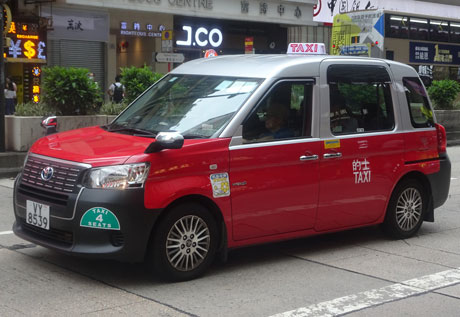
New Toyota Comfort LPG/electric hybrid taxi introduced into service from January 2019
Taxis are comfortable and have plenty of boot space for luggage, usually being able to carry at least three regular size suitcases. All taxis are fitted with seat belts and it is mandatory for both driver and passengers to wear these. During 2010 there were 1409 prosecutions of taxi drivers or passengers for failure to wear seat belts. Smoking is not allowed in taxis.
Taxis can also be booked by telephone for which a HK$5 surcharge applies.
Between 2001 and 2004 about 99% of taxis were converted from diesel and now operate on cleaner LPG fuel.
Wheelchair accessible taxis are operated by Diamond Cabs and Chung Shing Taxi Co. Diamond Cabs, which operates as a social enterprise, operates seven Toyota Noah Welcabs which are designed for wheelchair access with a mechanical ramp at the rear. These cabs must be pre-booked. A further 200 Nissan SynCab taxis, operated by Chung Shing Taxi, capable of carrying passengers in wheelchairs are eventually expected to be in service. The first 20 (15 red urban taxis and 5 green New Territories taxis) were commissioned in February 2015 and by April 2017 the company had about 140 SynCabs in service. The SynCab taxis have four seats, a large trunk with capacity for up to eight large bags and are equipped with wi-fi and USB ports.The taxis must also be pre-booked either by phone or SynCab mobile app. Normal rate per km applies but there is a HK$60 booking fee. Cash or credit card can be used for fare payment. PrimeCab Hong Kong also operates more than ten larger capacity Ford Transit Connect taxis. In December 2016 Jumbo Taxis, a partnership between Future Motors and taxi operator Chow Kwok-Keung, was launched with a fleet of 40 Ford Connect Transit vehicles, capable of holding up to nine pieces of luggage, and equipped with free Wi-Fi and a mobile phone charging service for passengers. The taxis are also equipped with devices to monitor driving habits and deter drivers from taking longer routes. The Jumbo fleet had expanded to 70 taxis by April 2017. Taxis can be hailed on the road but a booking fee of HK$50 applies for bookings via a hotline. The company is targeting corporate clients and business passengers and will not offer wheelchair access.
As at March 2024 a total 4,697 taxis were wheelchair accessible representing about 26% of the total taxi fleet of 18,163. These comprised 4,196 Urban, 495 NewTerritories and 6 Lantau taxis. The Government is planning to introduce a taxi fleet regime during 2024 under which existing taxis may form a fleet and apply to the Transport Department for a Taxi Fleet Licence. The Transport Department will regulate the operation and management of the taxi fleets through license conditions, and specify that the fleet must include a certain number of wheelchair accessible taxis so as to facilitate travelling by wheelchair users. The government plans to invite the trade to apply for Taxi Fleet Licences in April 2024, and it is expected that more wheelchair accessible taxis will come into service in phases.
In August 2021 Hong Kong's most popular taxi app operator, HKTaxi, was bought by Uber and as at November 2021 had over 70,000 registered taxi drivers signed up to the app. Uber already has a taxi operation in Hong Kong, Uber Taxi, established in October 2020 which charges flexible fares rather than by the meter.
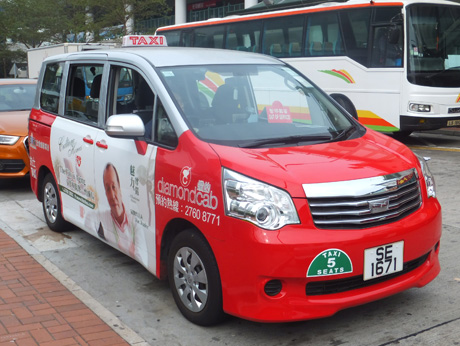
Diamond Cab wheelchair accessible taxi
Large capacity Nissan Syncab New Territories taxi, introduced in 2015 and operated by Chung Shing Taxi Co
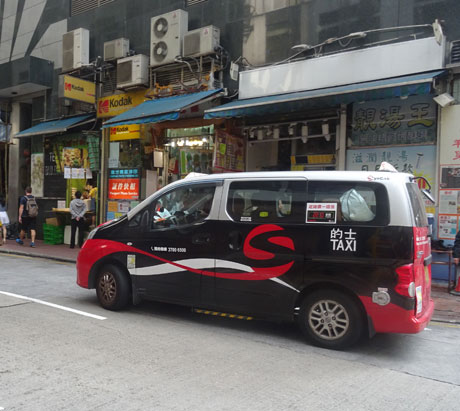
Urban Nissan Syncab
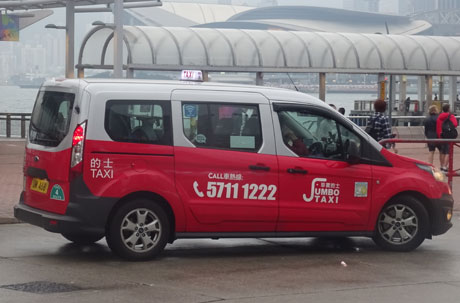
Jumbo Taxi's fleet of taxis with large luggage capacity is expanding rapidly since its launch in December 2016
Most drivers speak or understand at least a little English and will be able to get visitors to hotels, public transport locations and popular tourist attractions without any problem but to avoid any confusion it is often advisable to have your destination written in Chinese or a map to point to. In November 2007 the Hong Kong Tourism Board took the initiative of issuing all taxi drivers with a bilingual translation booklet in English and Chinese detailing names and addresses of hotels, landmarks and tourist attractions with the intention that drivers allow passengers to scan the booklet to help establish their correct destination and avoid any confusion.
Taxi drivers are not obliged to change HK$500 or HK$1000 notes.
All taxi drivers are required to display a taxi driver identity plate. In October 2018 a new taxi driver identity plate was introduced with a validity period of ten years to replace the previous plate which was only valid for one year. The new plate is being rolled out following requests from taxi and Public Light Bus trades for a longer validity period of driver identity plates, and as one of the facilitation measures put forth in the report of the Public Transport Strategy Study released in June 2017. Existing one-year plates will continue to be valid until their expiry date.
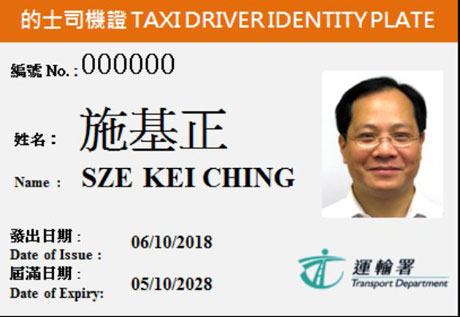
New 10-year taxi driver identity plate rolled out from October 2018 - Front
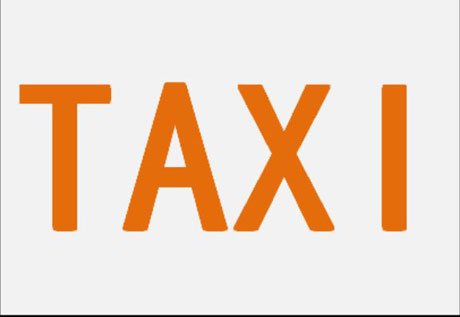
New 10-year taxi driver identity plate rolled out from October 2018 - Back
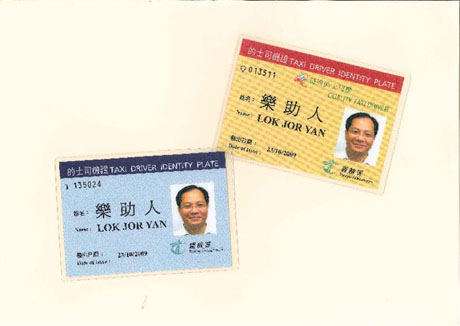
Old version annual taxi driver identity plate which was issued between October 2009 and September 2018
In June 2015 a government review to establish whether the existing taxi supply can meet demand made a preliminary assessment that the number of licenced Lantau taxis should be increased by 25 to 75* but that the existing supply of urban and New Territories is adequate. In addition, the Government is to review the role and positioning of taxis under the Role and Positioning Review (RPR) of the Public Transport Strategy Study. It was expected that the entire RPR wouldl commence in mid-2015 and be completed in 2017.
* Tenders for an additional 25 Lantau taxi licences were invited in December 2015 with a deadline of 11th January 2016. These additional Lantau taxis began service during the second quarter of 2016.
Effective from 1st October 2020, all applicants for a full taxi driving licence must attend and complete a pre-service course for taxi drivers at a pre-service training school designated by the Commissioner for Transport and obtain a course certificate, in addition to passing the relevant written test, within one year prior to applying for the full driving licence before they can be issued with a full driving licence. The course covers knowledge of driving safety and road safety which help to enhance the awareness of driving safety of taxi drivers.
In December 2020 to coincide with the opening of the Tuen Mun - Chek Lap Kok Tunnel the government permanently waived the Lantau Link toll fee resulting in a reduction in taxi fares between most destinations and the Hong Kong International Airport and substantial fare reductions between the airport, North Lantau and Tuen Mun district owing to the shorter journey distance.
In response to the worsening situation regarding the COVID-19 pandemic in Hong Kong, from 19th February 2022 a designated fleet of about 300 taxis were contracted to the government to provide transportation for people with mild symptoms of infection between their residences and designated clinics. Drivers of the designated fleet were required to wear protective equipment, including protective face shields (while not driving), masks and protective gowns, and fully disinfect the compartments every day and perform a daily rapid antigen test before providing services. Drivers had to test negative for the virus before providing these services. In order to reduce the infection risks, passengers were only allowed to use the back seats of the taxis, as the front passenger seat had to be left vacant. The designated fleet was only authorised to transport those with appointments made with the designated clinics, and not pick up other passengers. The designated taxi fleet arrangement was terminated on 14th January 2023 following a relaxation of covid pandemic rules. During its period of operation over 1,300 taxis participated in the fleet and made over 378,000 trips. The total expenditure was about HK$271 million.
In October 2022 taxi operator SynCab Taxi announced it was introducing two wheelchair-friendly taxis into service on a trail basis. The Nissan Serena e-Power taxis are equipped with five seats for customers, including two separate seats in this middle row and two that can be converted into wheelchair seats in the rear row. An adjustable ramp is installed in the rear compartment to allow wheelchair users easy access to board and leave the vehicle. The taxis, which cost HK$400,000 each. Following a four to six months trial period, 100 vehicles are expected to be introduced. The fare for the taxis will be the same as ordinary ones with credit card payment accepted and a booking service fee of HK$120 applies.
As at May 2023 Hong Kong had 3,900 wheelchair accessible taxis. Additionally, there are private vehicles issued with hire car permits that provide wheelchair accessible vehicle pick-up and drop-off services. The number of vehicles providing such services at May 2023 is 50, and these vehicles are held by 28 hire car permit holders. The Government has does not intend mandating all taxis be replaced with wheelchair accessible models at the current time. However, under the concept of "Transport for All", the Government has been actively encouraging the taxi trade to introduce more wheelchair accessible taxis and different models, so that wheelchair users may have more choices and more convenient access to wheelchair accessible taxis. The Government will continue to communicate with the taxi trade and vehicle suppliers to help them better understand the relevant standards and approval procedures for introduction of wheelchair accessible taxis, thereby facilitating their search for suitable wheelchair accessible taxi models for use in Hong Kong.
In February 2023 in the Budget Speech the government announced a target of introducing 3,000 electric taxis by the end of 2027 and will put in place a loan scheme with 100% guarantee for the taxi trade as an incentive for taxi owners to replace their existing taxis with battery electric taxis. It is estimated that the proposed measure will involve a loan guarantee of about HK$6.4 billion. The details of the scheme will be announced in due course.
In December 2023 the government approved a demerit system in an attempt to approve taxi driver behaviour and the reputation of the industry. Drivers will receive 3, 5 or 10 demerit points for violating any of 11 offences. Overcharging and wilfully refusing or neglecting to accept a hire will result in 10 points. Five and three points will be given for acts such as using a route other than the most direct one and refusing to carry the number of passengers requested, provided the total is within the vehicle’s capacity. Drivers who accumulate 15 points or more within two years may be disqualified from operating a taxi for three months. A six-month suspension will be imposed on repeat offenders. The demerit system is effective from 22nd September 2024 and details can be found at the following link;
https://gia.info.gov.hk/general/202409/12/P2024091200260_471011_1_1726115650480.pdf
In late 2023 taxi industry representatives proposed an increase in fares based on revised flagfalls of HK$32 for Urban taxis and HK$28 for New Territories taxis and a 20 cent increase in the incremental fare for each subsequent 200-metres. The proposal replaces an earlier one which suggested a HK$6 increase in flagfall but no increase in the incremental rate. If agreed by the Transport Department it is hoped that the increase would approved by the Legco before the end of the first quarter of 2024.
Octopus Cards Limited has announced it will enable Union Pay, Alipay and Alipay HK contactless payment in taxis equipped with Octopus fare machines from 25th January 2024.
In January 2024 it was announced that the first government-certified smart meter for the taxi industry, offering a range of features like on-demand service booking, electronic payment, and receipts is to be installed in 100 taxis starting in March 2024 on a trial basis. The meter can also provide a fleet management function and support multiple electronic payment methods, including QR codes, credit cards, NFC, and overseas mobile wallets. Drivers ca use the system to calculate fares such as toll roads and tunnels or other service charges. It is planned to install the new meter in 100 urban and New Territories BYD taxis in the first phase, expanding to 1,000 taxis by the third quarter of 2024. The smart meter has been developed by Mobile Shop, a local taxi management operator in collaboration with the Automotive Platforms and Application Systems R&D Centre under the Productivity Council. The system was launched in early April 2024 by which time 1,500 smart meters had been installed in taxis, expected to increase to over 8,000 by the end of 2024.
In May 2024 the Government approved an increase in taxi fares to take effect from 14th July 2024. The flagfall for all taxis (Urban, New Territories (NT) and Lantau) will increase by HK$2 to HK$27, HK$23.5 and HK$22 respectively. The incremental charge for the first-tier distance after flagfall will increase by HK$0.2 and the incremental charge for second-tier distance after flagfall will increase by HK$0.1.
In December 2024 the Government announced its Green Transformation Roadmap whereby it will subsidise the taxi trade to purchase 3,000 e-taxis and provide at least 500 fast chargers by the end of 2027. Each taxi operator will receive a subsidy of HK$45,000, which represents about 10% to 25% of the current market price. Owners the oldest taxis, over 12 years of age will be prioritised .
Also in December 2024 the Government indicated it intends to legislate for taxis to install electronic payment and navigation systems, dashcams and on-board surveillance cameras over the next two years under efforts to improve service quality. All taxis will be required to install electronic payment options by the end of 2025 and have cameras installed by the end of 2026.
From January 2025 taxis will be able to accept payment through HSBC's PayMe mobile app through the Octopus app payment networks, which already accepts UnionPay, AlipayHK, and mainland Alipay payments as well as adding WeChat Pay HK and WeChat RMB wallet payments.
In July 2025 the government introduced legislation requiring all taxis to accept fares by electronic payment (e-payment) and install journey recording systems capable of making video recordings with audio inside a taxi compartment (in-vehicle recordings) as well as making video recordings of the clear front and rear views outside the taxi by 1st April 2026.
TAXI FLEETS
In April 2024 in a bid to improve the quality of taxi services the Transport Department invited applications for Taxi Fleet Licences. The deadline for applications was the end of May 2024 with no more than five fleet licences to be issued in this initial phase. At the end of the application period on 31st May 2024, fifteen applications had been received by the Transport Department for consideration. On 31st July 2024 the government announced the five applicants awarded Taxi Fleet Licences are Big Boss Taxi Company Limited, CMG Fleet Management Limited, Sino Development (International) Company Limited, SynCab Service Limited and Tai Wo Management Limited. Conditional grants of the Taxi Fleet Licence were issued to them accordingly, and they are required to complete the gearing-up work and commence services within one year. By that time, each taxi fleet will be issued with a Taxi Fleet Licence with a validity period of five years. The TD will actively promote and assist the taxi fleet operators to commence operations as soon as possible. The selected applicants include three urban fleets and two mixed fleets, with a fleet size of 300 to 1,000 taxis each, providing a total of over 3,500 taxis, which account for nearly 20% of the total number of taxis in Hong Kong. The operators will deploy about 1,500 new vehicles in total as fleet taxis at the time of service commencement, accounting for over 40% of the total number of fleet taxis. The vehicle age of the remaining fleet taxis will not exceed three years. A certain number of wheelchair-accessible taxis and premium taxis, as well as electric taxis of more than one-fourth of the fleet, will be put into service in phases for each taxi fleet to cater for the diverse travel needs of individuals and promote green transport. To ensure the service quality of drivers and driving safety, the selected applicants will provide appropriate training to fleet drivers and formulate measures to monitor the driving behaviour and service performance of the drivers. They will also maintain an employer-employee relationship with a certain number of drivers in their fleets to enhance the stability of the fleet driver group and create a better working environment. Meanwhile, safety devices, including the Global Positioning System, dash camera, and driver monitoring system (equipped with functions including lane departure and improper driving behaviour detection), will be installed inside the vehicle to ensure driving safety. All taxi fleets will provide online hailing services. Members of the public can choose appropriate vehicle types (such as general taxis, premium taxis, wheelchair-accessible taxis) through the online hailing platforms (such as mobile applications and websites) provided by the taxi fleets according to their personal needs. All fleet taxis will provide multiple electronic payment means for passengers' convenience. In addition, all taxi fleets will provide customer service hotlines and different electronic communication channels for passengers to rate driver services. A complaint handling mechanism will be provided to handle customer enquiries and complaints in a timely manner. Taxi fleets will be allowed to set their own fares for booked trips, which may be in the form of a pre-agreed booking fee on top of the metered fare, or a lump sum fare agreed with the passenger before the journey starts. Fleet licensees will also allowed owners to design the livery and marking of their fleet taxis. The Government will also publicise the licensed taxi fleets through its official channels and designate a few dozen fleet taxi stopping places at the airport, some of the boundary control points (including the Heung Yuen Wai Port, the Shenzhen Bay Port and the Hong Kong-Zhuhai-Macao Bridge Hong Kong Port), the West Kowloon Station of the Guangzhou-Shenzhen-Hong Kong Express Rail Link, some Airport Express Stations, Kai Tak Cruise Terminal, Hong Kong Disneyland, etc, to facilitate fleet taxis' picking up of passengers who have booked a journey. The Government has identified two sites in Tsing Yi and Tai Po and plans to grant the sites on a short-term basis for co-use by taxi fleet licensees for purposes such as parking and basic maintenance to enable fleet licensees provide better maintenance and management for their fleet taxis and enhance service quality.
The first fleet of about 200 premium taxis operated by Tai Wo Management under the “JOIE” trading name began operating on a trial basis from 31st March 2025 under a conditional temporary approval notice for taxi fleet licence, issued by the Transport Department in July 2024. The fleet comprises MAXUS MIFA7 electric six-seater vehicles, Toyota Noah wheelchair-accessible cars and Toyota Comfort hybrids. The “JOIE” app is available for download on various mobile app stores in Chinese, English, Arabic languages. More languages may be available at a future date. Customers are required to give a minimum one hour’s notice to book a taxi and can book up to 24 hours in advance. JOEI and the four other selected operators are required to begin operating their around 3,500 licensed taxis in a trial phase by July 2025 before a full fleet licence is issued once authorities confirm them fully ready for official service.
The Transport Department announced that from 30th May 2025 two premium taxi fleets, Joie and SynCab, have been authorised to pick up pre-booked passengers at designated locations within prohibited zones at the Shenzhen Bay Port and the Hong Kong Port control point of the Hong Kong-Zhuhai-Macau Bridge. Passengers can book via Joie and SynCab’s mobile apps or other compatible online taxi-hailing channels.
Following a trial period five fleet operators have been awarded licences to officially commence operations from July 2025. The licenced fleet taxis are able to use about 80 designated taxi fleet stopping places across 13 locations, including the airport, certain cross-boundary control points and other tourist hotspots to pick up passengers with pre-booked trips. Signage, information plates, and display panels is to be erected at these locations. The Transport Depratment will also distribute leaflets and display posters featuring QR codes for each taxi fleet's online hailing service to facilitate reservations by the public and tourists. The Government will also promote the taxi fleet services to the public and tourists through various channels, including the TD's HKeMobility mobile application, and the networks of the Hong Kong Tourism Board, the Airport Authority, and the Kai Tak Cruise Terminal. The number of fleet vehicles in service at the launch of the taxi fleet scheme is expected to be about 1,000.
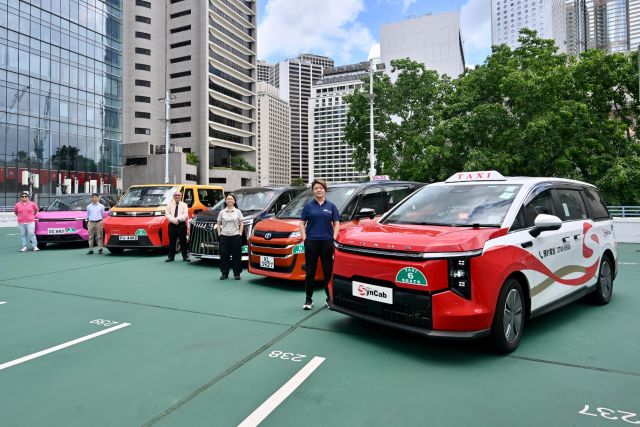
Representatives of the initial five taxi fleet operators and their fleet taxis
The first official Taxi Fleet Licence was issued to SynCab Taxi (mixed fleet), operated by SynCab Service Limited, in accordance with regulation 12E(1) of the Road Traffic (Public Service Vehicles) Regulations (Cap. 374D) for a period of five years. The fleet officially commenced services on 14th July 2025.
Licences for four further fleets were issued on 28th July 2025 with operators commencing service on that date. The four additional fleets are Big Boss Taxi Company, CMG Fleet Management Ltd, Sino Development (International) Company Ltd and Tai Wo Mangagement Ltd.
The Transport Department has approved the taxi livery design and markings of the fleet. For easy identification by passengers, all fleet taxis are required to display fleet taxi plates at the front and rear of the taxi bodies, and a fleet taxi certificate on the windscreens of the taxis;
https://gia.info.gov.hk/general/202507/14/P2025071400301_502369_1_1752464483690.pdf
All fleets provide online hailing services. Fleet taxis may customise fares for
pre-arranged journeys, charging a booking fee on top of the metered fare or
charging a lump sum fare before the journey starts. Both must be agreed with
the hirer in advance. The fares of fleet taxis may vary for pre-arranged
journeys depending on the circumstances at the time of booking and the types of
taxis requested by the passenger. For example, higher fares may be charged
during peak hours or when the passenger requests a premium taxi. For
street-hailing trips, fleet taxis shall charge according to the same fare
schedule as general taxis.
The Transport Department has set up a taxi fleet website;
https://www.td.gov.hk/en/transport_in_hong_kong/public_transport/taxi/tfli2024/index.html
About 80 designated fleet taxi stopping places have been set up across 13 locations including the airport, certain boundary control points, the Hong Kong West Kowloon Station of the Guangzhou-Shenzhen-Hong Kong Express Rail Link, some Airport Express stations, the Kai Tak Cruise Terminal and the Hong Kong Disneyland. Information plates will be installed at these locations.
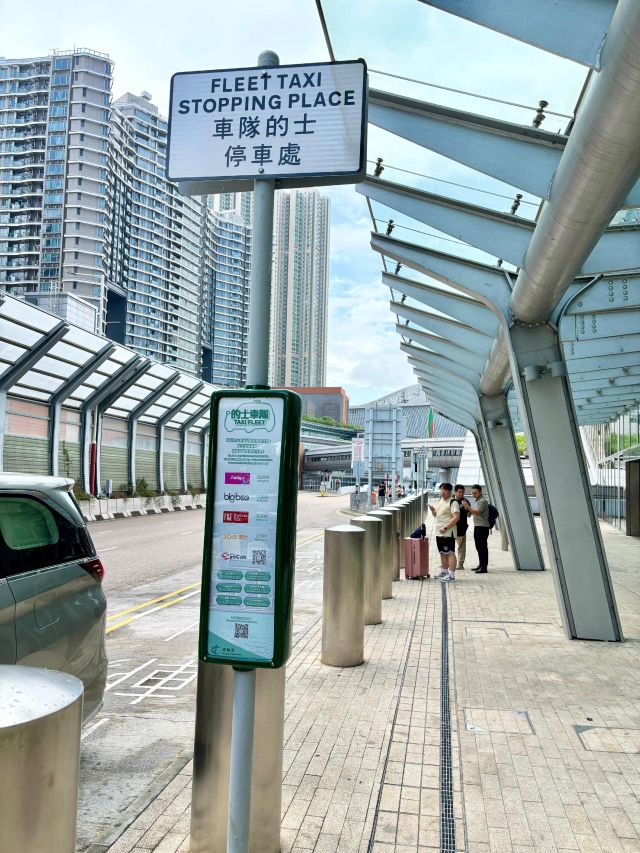
Information sign installed at a designated fleet taxi stopping place at the Hong Kong West Kowloon Station of the Guangzhou-Shenzhen-Hong Kong Express Rail Link
HIRING A TAXI
There are 75 taxi stands on Hong Kong Island, 104 in Kowloon, 233 in the New Territories and 26 on Lantau Island. The complete list here can be viewed here;
http://www.td.gov.hk/filemanager/en/content_276/taxi_stand20071203.xls
There are also at least 230 designated taxi pick up / drop off points and 46 drop off points.
Taxis can be hailed in the street. When a taxi is for hire this is indicated by a red “For Hire” visible through the windscreen and at night a red illuminated “Taxi” sign on the roof of the cab. In 2003 the Transport Department introduced a scheme for relaxation of no stopping restrictions (NSR) on roads with a speed limit of less than 70km per hour for taxis picking up and setting down passengers, meaning that taxis can now pick up and drop off almost anywhere, provided they do not cause an obstruction. However, taxis are not allowed to wait for passengers on roads with NSR. The scheme, under which taxi owners/drivers must apply for a permit for exemption from picking up or setting down on roads with NSR, is reviewed annually with the latest exemption expiring on 31st January 2019. However, in line with recommendations in the Public Transport Strategy Study published in June 2017, starting from 28th December 2018 works will progressively be carried out to permanently relax the restrictions on taxis for picking up or setting down passengers in all designated restricted zones on roads with speed limit at 70 kilometres per hour or below. Supplementary traffic signs displaying "except taxi pick up or drop off" beneath traffic signs with a no-stopping restriction will progressively be erected in restricted zones across the territory. This will spare the taxi trade the need to renew restricted zone permits annually. The works are expected to be completed by 2021. Before the completion of the works, restricted zone permits will continue to be issued to the taxi trade at the end of January each year. Taxi drivers have been reminded to continue to exercise self-discipline and to strictly observe the "pick up, drop-off and go" and "no waiting" rules. In the event of violations of the rules causing obstruction to other road users, the Government may consider implementing traffic control measures, including restoring the no-stopping restrictions for taxis at certain road sections.
Taxis are usually in plentiful supply day and night in urban areas and at public transport interchanges and can usually easily be hailed in the street or by a hotel concierge. In rural areas of the New Territories and on Lantau Island taxis are a little more scarce. Several taxi operators provide a telephone booking service and details can be found below.
The vast majority of taxis are Crown Comfort, made by Toyota, who until recently enjoyed a monopoly on supply of Hong Kong taxis through local Toyota agent Crown Motors. However, following discussions with the Hong Kong Government regarding conversion of taxis to electric-powered vehicles, Chinese car maker BYD, agreed to pay HK$13.5 million to cover the construction costs of 45 quick-charging points in 15 public car parks, and another HK$9 million in provisional subsidies to help taxi operators buy 45 of its e6 electric vehicle models. Subsequently, the Hong Kong Taxi and Public Light Bus Association agreed to rent 45 e6 models from BYD at a total monthly rent of HK$360,000. A six-month trial of the first ten 4-passenger BYD electric taxis began in May 2013 but was suspended the next month when one of the charging units overheated and all other charging points were closed as a precaution. The trial subsequently resumed and all 45 BYD taxis were put into in service but by mid-2015 the number had reduced to 35. At the beginning of the trial there were only 17 BYD charging points ready for use, with BYD taxis being unable to use the existing 10 quick charging points and 1000 slow charging points around the city as these are only compatible with Japanese built taxis. Over 80% of the existing charging points are common 13A domestic type chargers which can take over 10 hours to fully charge an electric car. The BYD electric taxis have much less boot space for luggage storage than the existing Toyota taxi fleet. BYD had predicted that 3,000 electric taxis would be in service by the end of 2015 but in November of that year BYD admitted the trial had been a failure with no more electric taxis having been added to the fleet.
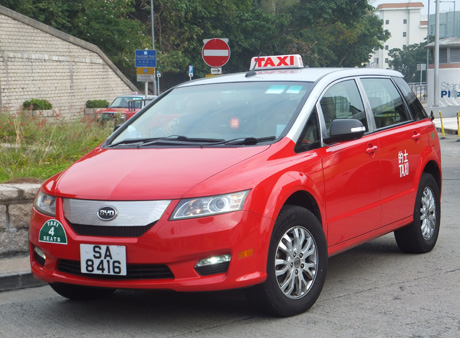
A small fleet of Chinese built BYD electric taxis has been operating in Hong Kong since May 2013
Crown Motors, the sole distributor for Hong Kong's main taxi supplier, Toyota, received orders for 20 Prius hybrid taxis in late 2012, which were introduced into service during 2013. Although Toyota had previously said that its hybrid cars were not intended for commercial use, the Prius has already been succesfully operating in taxi fleets in many major cities including Sydney, Paris, Toronto and Tokyo.
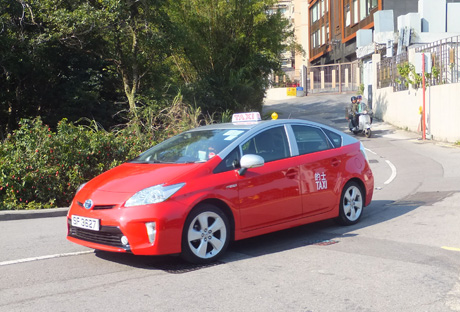
Toyota Prius taxi seen on Mount Austin Road, The Peak
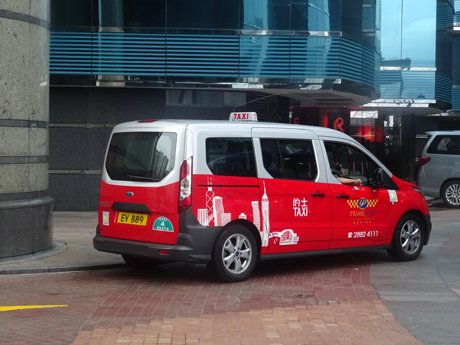
About 20 Ford Connect Transit taxis have been introduced by PrimeCab Hong Kong since 2015
In March 2013, the government's Environmental Protection Department approved applications from six companies for funding from its Pilot Green Transport Fund for trials of nine Toyota wheelchair accessible electric taxis, some of which were in service by early 2014.
Other manufacturers are also making efforts to break into the Hong Kong taxi market. Nissan, which in 2012, relocated the global headquarters of its luxury car division, Infiniti, from Japan to Hong Kong, and which was once the dominant supplier of taxis to Hong Kong before Toyota offered cheaper repair costs, confirmed in September 2012, it was in discussions to introduce 50 Nissan Leafs for trial, followed by a larger trial of 100 of its next generation eNV200 model electric car. In July 2012, the Environmental Protection Department had approved an amount of HK$11 million from the Green Transport Fund to import five electric taxis and two electric buses from Fiat for a two-year trial in the New Territories. Each taxi costs about HK$1.28 million, over five times the HK$240,000 cost of a traditional cab. In Italy the cabs travel about 200 kilometres before recharging but it is hoped the capacity can be increased to 280 kilometres in Hong Kong. The taxis take about 45 minutes to charge. However, in May 2017 the Environment Bureau acknowledged the failure of a 2-year trial of electric taxis since the long charging time makes the vehicles unsuitable for operating round the clock. Three electric e6 taxis made by Chinese manufacturer BYD used in the trials have been re-registered as private cars. In April 2021 the Environment Bureau indicated it would initiate a new trial of electric taxis in Sai Kung and Lantau Island believed to be using Korean manufactured vehicles. Sites for chargers to be installed have been identified but so far no indication as to the number of vehicles to be involved in the trial has been given.
Ford Motor Company, which has opened a dealership in the city with Inchcape Far East Company, launched an upgraded taxi version of its Transit Connect LPG powered car in Hong Kong in February 2015. The taxi costs about HK$250,000, about HK$30,000 more than the Toyota Crown Comfort , but the vehicle which has four seats has sliding doors and a more spacious interior and headroom, with a luggage capacity of 1,656 litres, about three times more than the Toyota Crown Comfort. The model is expected to be more attractive to taxi operators who do airport runs owing to its large luggage capacity and by early 2017 PrimeCab Hong Kong was operating about 20 Ford Connect taxis. Chinese car manufacturer Geely Automobile, who produce the London cab, have designed a modified LPG fuelled cab with wheelchair access, suitable for the roads of Hong Kong and was believed to be planning talks with local taxi operators.
In November 2017 four Hybrid LPG and electric powered new generation Toyota Crown Comfort taxis were delivered to Crown Motors, the sole distributor of Toyota taxis in Hong Kong. The taxis, costing HK$300,000 each, are expected to achieve a running cost of about half that of traditional LPG taxis, with a travelling distance of about 19.4km per litre`compared to 9km per litre. The taxis have a four passenger capacity and an electric rear sliding door to allow wheelchair access. The taxis are to undergo safety and compliance tests by government departments and are expected to be introduced into service in 2018 following which production of existing models of Crown Comfort taxis will cease. Toyota’s market share of Hong Kong taxis exceeds 90% and over 10,000 existing Crown Comfort models are over 13 years old and due for replacement.
In June 2011, following a six-month trial involving 240 taxis, Autotoll, Dah Sing Bank and Visa launched the "autoTAXI" system whereby users of Visa credit cards and Visa payWave cards are able to pay taxi fares by credit card. At launch date the system, which cost HK$10,000 was installed in about 100 taxis and had been fitted to about 600 taxis by the end of 2011. Users of Visa payWave cards were able to swipe the card against a reader, whilst users of Visa credit cards could insert the card in the machine to be processed. No signature was required for less than HK$500. "autoTAXI" system taxis were identified by a "white wings" symbol and were nicknamed "flying taxis". However, the autoTAXI service ceased operation on 10th September 2012.
In January 2017 SynCab announced it was operating a pilot scheme during a two week period which would allow its 32 premium taxis to accept credit card payment and offer free Wifi and mobile charging in its cabs.
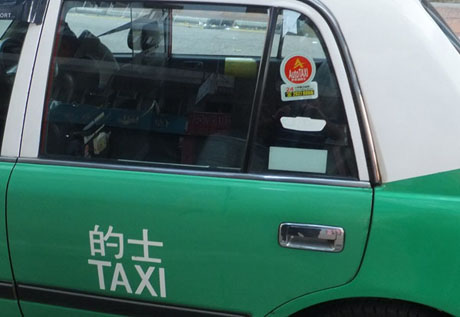
Taxis installed with "autoTAXI" system accepting Visa cards displayed "autoTAXI" logo and "white wings" on rear door quarter glass before the service was discontinued in September 2012.
Between December 2010 and May 2011 a pilot programme took place whereby 31 taxis were equipped with hand-held Octopus Card readers allowed passengers the option of paying by Octopus Card at the end of their journey. This has resulted in Octopus Cards Limited teaming up with multimedia platform company Motion Power to fit taxis with Octopus Card readers but progress has been slow and by early 2013, about 500 taxis were equipped. One reason for taxi drivers reluctance to accept Octopus Card payments has been that drivers are required to pay HK$250 a month to rent the Octopus Card reader plus an administration fee of 1% of daily revenue. Payments are not transferred into the taxi owners bank account until the next day, leaving some drivers who pay cash to rent vehicles from owners on a daily basis short on cash flow. As an incentive to encourage more drivers to accept Octopus payment, from February 2012 Octopus Cards Limited began paying drivers a guaranteed rebate of HK$3 each time a passenger pays the fare by Octopus Card. Octopus Cards indicated in March 2013 that it would increase the rebate to HK$5 to persuade more taxi operators to take up Octopus as a payment method. An iPhone app "TaxiGo" has been launched which uses GPS to list nearby taxis including Octopus taxis and allows passengers to order one with the touch of a screen. A previous Octopus trial in 2006 involving 20 New Territories taxis had failed, one reason being that taxi drivers had to return to their office at the end of each shift to enable accounting formalities to be completed. Octopus Cards introduced a QR code app in November 2017 enabling passengers to scan the QR code provided by taxi drivers to make payment. However, this was limited to Android phones and in March 2018 Octopus Cards announced it was to make another major attempt to break into the taxi market by introducing an app "Octopus App for Business" which drivers can download to a smartphone which acts as a card reader for both Android devices and Apple iPhone. About 1,000 drivers had signed up for the app at the time of its launch on 3rd May 2018. In August 2018 Octopus Cards in collaboration with Wetaxi Technology Company launched a mobile taxi-hailing platform "WETAXI HK" enabling passengers to hail taxis and make fare payment with the app by Octopus Card. The app also features a driver rating system, through which passengers can rate drivers based on their driving manners, taxi cleanliness, personal demeanour and service quality. In the WETAXI HK version for drivers, information such as instant traffic reports and speed detection will be provided to reduce traffic accidents. These features will be launched during the second phase of service upgrade
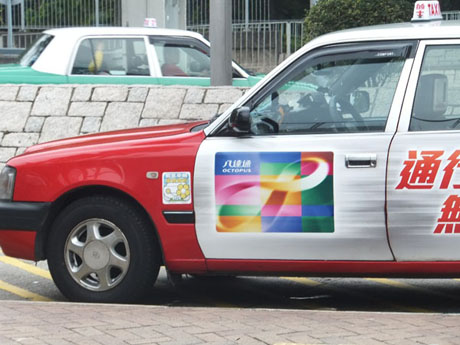
Some taxis accepting Octopus Card payment display the Octopus logo on the front passenger doors
During late 2017 e-payment platforms had entered the Hong Kong taxi market with about 1,500 taxis signing up with Alipay and 1,000 taxis having signed up for WeChat Pay transactions. WeChat Pay was aiming to secure half the market within three to six months.
In October 2011 a free "app" for smartphones, "TaxiShare" was launched, which is intended to help people share taxis by finding other passengers who wish to travel in the same direction. The app uses GPS to display passengers location and connect with others within a 250-metre radius via a chatroom. The app is available for iPhone and Android users. Another app “Taxiwise”, developed at Hong Kong Science Park by a group of American, French and local IT professionals and aimed at people unable to speak Cantonese was launched in December 2013. The app translates destinations into Cantonese before matching the customer with a cab and has a target of having 1,000 drivers by mid-2014. Luxury taxi service Uber launched in Hong Kong in July 2014 and launched UberVan in January 2015 but has experienced regulatory problems and in August 2015 five Uber drivers were arrested for operating a hire car without a permit (the number of hire car permits in Hong Kong is limited to 1,500) and insurance and two office interns were taken into custody but all were later released. Uber withdrew its taxi and van services in Hong Kong from 5th September 2016 to focus on its "core-business" car sharing services UberX and UberBlack which are used by the vast majority of passengers and drivers. Mainland IT company Tencent and Easy Taxi, which teamed up to launch a taxi booking service via smartphone app WeChat in Singapore in December 2013 are believed to be planning to roll the service out in Hong Kong. In July 2014 the Government's Legislative Council transport panel was informed that the police and Transport Department are monitoring the legality of taxi services provided through the growing use of smartphone apps. Alibaba's Kuaidi Taxi app, the most popular taxi app on the Chinese mainland, was launched in Hong Kong in August 2014 using regular metered fares but with an opening offer of a HK$20 rebate for all hirers collected through HSBC or Hang Seng Bank transfers or in cash from centres in Mong Kok, Kwai Chung and Causeway Bay. The app initially, however, is only available in simplified Chinese. Kuaidi also offers a customer loyalty scheme allowing passengers to accumulate points for each ride which can be redeemed for a small cup of coffee at Pacific Coffee. Other mobile apps which provide platforms for taxi drivers include HKTaxi and GoGo Taxi. By mid-2016 there were about 20 taxi apps available in the iTunes App Store including the first taxi industry-organised app "TAXI", introduced by the Taxi Council in May 2016. The app, intended to improve service quality and compete better with rival taxi services such as Uber, refers customers to drivers endorsed by the council, who must sign up to a "performance pledge", and includes a complaint system with complaints being followed up within 48 hours of being filed. At the time of its launch about 800 drivers were registered as endorsed with a further 700 endorsed drivers and 3,500 independent drivers expected to be registered under the app within a month. In April 2019 the Hong Kong Taxi Council launched its "eTaxi" app in response to complaints including refusing trips in a move to provide better service, more payment options and to compete with Uber. The app allows users to identify taxis near their location, check estimated fares and choose a payment method including Octopus. The app, which also has call centre support, had 4,000 taxi drivers signed up at its launch. Also in April 2019 Easy Planet launched its "SuperCab" app offering a premium service with vehicles less than 5 years old and agreed fares rather than meter-based fares.
The Government's Public Transport Study (PTS) commenced a review into taxi services in mid-2015 and is expected consider the possibility of introducing premium taxi services and promoting "hire as a whole" taxi services, for which provision is already made under the Road Traffic Act, as an alternative option to charging by the meter. See paragraph "HIRING A TAXI AS A WHOLE" below for more information. The whole PTS is expected to take about two years to complete but priority is to be given to studying taxi and car hire services. In the meantime, in order to compete better with Uber, a coalition of over half of Hong Kong's taxi drivers and 17 industry groups which own over half of the taxi fleet launched a smartphone app in the spring of 2016 on a pilot basis, initially offering 500 taxis with the aim to extend the service to 1,000 taxis by the end of 2016. Proposals in mid-2016 by the Transport Department to offer three premium taxi operating franchises, each for 200 taxis under a trial franchise scheme lasting five years met with resistance from the Hong Kong Taxi Owners Association but the regulatory requirements were approved in April 2019.Franchisees will be required to make a substantial investment of at least HK$50 million to meet regulatory requirements including using newer vehicles, accepting electronic payments and providing compulsory customer service and safety training for drivers. The taxis will operate throughout Hong Kong in areas currently served by urban taxis and operators will be able to charge higher fares than existing metered rates. The franchises will be non-transferable and non-renewable. However, following considerable opposition from the trade the government on 1st June 2020 confirmed its decision not to proceed with the Franchised Taxi Services Bill although, depending on further consultation, it may be reintroduced at a future date.
In September 2016 a newly formed taxi group representing owners of about 5,000 taxis, The Association of Taxi Industry Development, equipped 10 taxis with CCTV for a trial period in order to improve service quality and address complaints about poor conduct by some taxi drivers including refusing passengers, overcharging and taking unnecessarily long routes. Each taxi costs about HK$2,000 to equip. The association considered the trial a success and the intention is that all new taxis operated by the association's members will be equipped with cameras and that about 2,000 taxis will be equipped within a year. It is hoped that the government may eventually legislate to make CCTV compulsory in all taxis. Data, which is encrypted and can only be accessed with the consent of the association, is held confidentially for one month before being destroyed. The data will be accessed when requested by the police or for investigations or at the request of passengers subject to an administration fee of HK$300 plus the compensation equal to the hourly pay of the taxi driver. In February 2016 the same association launched a courtesy campaign by encouraging drivers to say at least two greetings such as "good morning" to passengers on each trip and installing a device for passengers to rate driver performance as "satisfactory", "average" or "unsatisfactory" to the back of the front passenger seat of 200 taxis. The rating is transmitted via GPS to the operator's control centre.
In July 2018 the Transport Department announced it was introducing heavier penalties and a demerit point scheme improve standards and to discourage taxi drivers from overcharging, refusing hires and other bad practices. The current maximum fine of HK$10000 and six months in jail for first time offenders will be retained but repeat offenders but repeat offenders can be fined a maximum of HK$25000 and one year in jail for overcharging, refusing to accept a hire, failing to take the most direct route, soliciting and altering or defacing taxi meters. Demerit points will be issued for a range of eleven offences with offenders accumulating 15 points in two years facing suspension of licence for three months or six months for repeat offenders.
In February 2021 a group of taxi industry members, including one of the main operators Jumbo Taxi, announced it was to put forward proposals to the Transport Department to introduce premium six-seat taxis to enable better competition with Uber. The two models proposed are the Toyota Noah Hybrid costing about HK$500,000 and Nissan Serena e-Power at HK$360,000. They cost about HK$500,000 and HK$360,000, respectively. If approved, the taxis would be introduced by late 2021 or early 2022.
In July 2021 it was reported that the Hong Kong Taxi Council is testing various electronic on-board driver monitoring safety systems which can assist in detecting bad driving such as tailgating, changing lanes without indicating or drivers dozing. It will canvass the government to make the system compulsory and provide subsidies for installation. It is hoped such a system can help reduce insurance premiums which have increased substantially in recent years.
In early 2022 the government approved a trial of electric taxis (e-taxis) including the installation of at least ten fast charging points on Lantau Island and in Sai Kung to support the trial. The first ten e-taxis involved in the trials are expected to enter service in mid-2022.
In May 2022 Visa, in partnership with Global Payments inc, began rolling out a "Tap to Phone" service enabling taxi passengers to pay fares by tapping contactless Visa cards on drivers Android smartphones. About 100 drivers at Chung Shing Taxi had signed up at the beginning of operation and Visa hopes to gradually expand the scheme to all taxi operators.
In April 2023 the government proposed introducing a taxi driver offence points and two-tier penalty system covering a range of offences such as excessive charging, not taking the most direct route and refusal to hire to improve the quality of taxi services following complaints from tourists.
From September 2023 Uber began offering metered taxi rides in partnership with HKTaxi with payment by credit card, Apple Pay, Google Pay and Paypal but not cash. Participating taxis carry Uber Taxi branding;
https://www.uber.com/en-HK/blog/uber-metered-taxi-launch/
In December 2023 it was announced that Hong Kong Tele-call Taxi Association had signed a contract with the world's leading electric vehicle manufacturer BYD, based in Shenzhen, to supply a fleet of 200 e-taxis by March 2024. The BYD model has been selected owing to its large boot which has a capacity for four large and two small suitcases. The government aims for a target of 3,000 fully electric taxis in service by the end of 2027.
In December 2024 Singapore-based ride hailing operator Tada entered the Hong Kong market with a "soft-launch" in competition with Uber. Its operation is initially restricted to Hong Kong Island, Kowloon and the airport. The company intends to further expand by the second quarter of 2025 but has no fixed date for a full launch.
In February 2025 taxi-hailing platform HKTaxi, founded in 2013, with over 70,000 registered drivers, announced it would cease operations on 1st April 2025 and encouraged users to switch to Uber which had acquired HKTaxi in 2021.
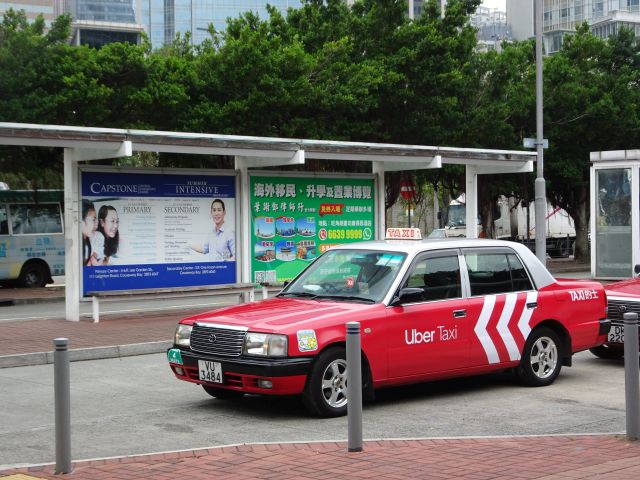
Licensed Urban metered taxi carrying Uber branding
In July 2025 the government introduced legislation requiring all taxis to accept fares by electronic payment (e-payment) and install journey recording systems capable of making video recordings with audio inside a taxi compartment (in-vehicle recordings) as well as making video recordings of the clear front and rear views outside the taxi by 1st April 2026.
The vast majority of taxi drivers are honest, helpful and courteous but if any passenger is not satisfied with the service provided, he should take a note of the driver's name, registration number of the taxi and the date, time and place of the incident and report to;
(a) the Transport Complaints Unit Hotline on 2889 9999 or 2577 6866 (Fax 2577 1858). Mailing address 22/F, East Exchange Tower, 38 Leighton Road, Causeway Bay, Hong Kong
or, if more appropriate;
(b) any police officer or police station. Police Hotline : 2527 7177
xxxxxxxxxxxxxxxxxxxxxxxxxxxxxxxxxxxxxxxxxxxxxxxxxxxxxxxxxxxxxxxxxxxxxxxxxxxxxxxxxxxxxxxxxxxxxxxxxxxxxxxxxxxxx
CURRENT FARE STRUCTURE (EFFECTIVE FROM 14th JULY 2024);
RED (URBAN) TAXIS;
HK$27 for the first 2kms then HK$2.1 each 200-metres up to HK$102.5 (9km), then
HK$1.4 each 200-metres over 9km.
Waiting time HK$2.1 per minute up to fare of HK$102.5 then
HK$1.4 from HK$102.5 upwards
Luggage charge HK$6 per piece except light luggage carried inside the passenger
compartment which is free*
GREEN (NEW TERRITORIES) TAXIS
HK$25.5 for first 2kms then HK$1.9 each 200-metres up to HK$82.5 (8km), then
HK$1.4 each 200-metres over 8km.
Waiting time HK$1.9 per minute up to fare of HK$82.5 then
HK$1.4 from HK$102.5 upwards
Luggage charge HK$6 per piece except light luggage carried inside the passenger
compartment which is free*
BLUE (LANTAU) TAXIS
HK$24 for the first 2 kms then HK$1.9 each 200-metres up to HK$195 (20km), then
HK$1.6 each 200-metres over 20km.
Waiting time HK$1.9 per minute up to fare of HK$195 then HK$1.6 from HK$195
upwards
CROSS HARBOUR TUNNEL TOLLS - From 2nd August 2023 under the government's new "633" fixed toll scheme cross-harbour taxis are charged an "all-day" fixed toll of HK$25 for any of the three road crossings (Western Harbour Crossing, Cross-Harbour Tunnel and Eastern Harbour Crossing). Taxi passengers will need to pay both the outbound and return toll (i.e. HK$50 in total) if they do not board from cross harbour taxi stands (SEE CROSS-HARBOUR TAXI JOURNEYS BELOW)
The fare element for using the Lantau Link was HK$30 but this toll has been permanently waived to all vehicles including taxis since 28th December 2020, corresponding with the opening of the Tuen Mun - Chek Lap Kok Tunnel resulting in a reduction in fares to and from the airport from most districts and substantial fare reductions to and from some parts of the New Territories owing to shorter journey distance.
There are no extra charges for night time journeys or for extra passengers.
* Under Road Traffic Regulations light personal hand baggage (including light suitcases, hat boxes, attache cases and similar articles) carried inside the passenger compartment of a taxi and wheelchairs and crutches carried by a disabled person who is a taxi passenger are not subject to the luggage surcharge. The size of "light personal hand luggage carried inside the passenger compartment" is not defined in the regulations. However, having regard to the views of the taxi trade and passengers, and the need to facilitate the daily operation of taxis (including preventing passengers from placing large pieces of baggage inside the passenger compartment so as to reduce the possibility of obstructing the driver's sightline, affecting the driving safety and causing damage to the compartment facilities, etc.), the Transport Department has introduced some reference guidelines, stipulating that a piece of light hand luggage may be placed inside the passenger compartment and carried free of charge if its total dimensions (the sum of the length, width and height) do not exceed 140 cm meaning a taxi driver may charge a luggage surcharge of HK$6 on each piece of baggage which is placed inside the passenger compartment and has the total dimensions (the sum of the length, width and height) exceeding 140 cm, or on each piece of luggage of any dimensions which is placed inside the luggage compartment.
xxxxxxxxxxxxxxxxxxxxxxxxxxxxxxxxxxxxxxxxxxxxxxxxxxxxxxxxxxxxxxxxxxxxxxxxxxxxxxxxxxxxxxxxxxxxxxxxxxxxxxxxxxxxxxxx
HIRING A TAXI AS A WHOLE
Regulation 38 of Hong Kong's Road Traffic Act (Public Service Vehicles) Regulations makes provision for a taxi owner to hire out a taxi as a whole, effectively allowing a taxi owner to bargain for business rather than charge by the meter. The rate of hire can be based on time during which the taxi is hired or any other terms agreed between owner and hirer. To comply with this regulation both parties must sign two copies of a document stating charges agreed, third party insurance details in respect of the taxi and names, addresses and driving licence numbers of the taxi driver/s. Each party must retain one copy of the document, which may be produced to a police officer, on demand, at any time during the hire, and in the case of the taxi owner, for up to three months after commencement of the hire.
CROSS-HARBOUR TAXI JOURNEYS
Taxi journeys between Hong Kong Island and Kowloon must pass through one of the three harbour tunnels i.e Western Harbour Crossing, Cross Harbour Tunnel and Eastern Harbour Crossing. Unless the journey commences from a cross-harbour taxi stand passengers will have to pay the return tunnel toll. However when the journey commences from a cross-harbour taxi stand only the single tunnel toll is charged. Cross-harbour taxi stands are clearly marked "Cross-harbour trips only. Single toll charge". Cross-harbour taxi stands can be identified in the list of all taxi stands on the Transport Department website;
http://www.td.gov.hk/filemanager/en/content_276/taxi_stand20071203.xls 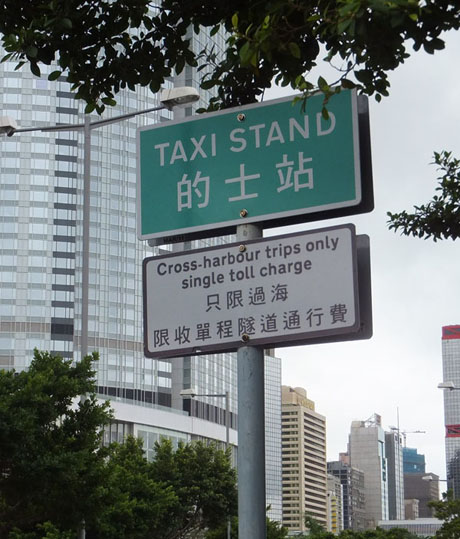
Cross-harbour taxi stands are clearly marked and avoid return tunnel toll being charged. The stand shown is located at Man Kwong Street, Central outside Central Pier 5
A GUIDE TO TAXI SERVICES IN HONG KONG
The Quality Taxi Services Committee of the Transport Department issues a useful Guide To Taxi Services in Hong Kong which can be viewed or downloaded at the link below;
http://www.td.gov.hk/filemanager/tc/publication/td_booklet_tra_web1.pdf
TAXI BOOKING SERVICE
THE FOLLOWING TAXI OPERATORS PROVIDE A TELEPHONE BOOKING SERVICE;
URBAN (RED) TAXIS
Kowloon Taxi Owners Association 2760 0411
United Friendship Taxi Owners & Drivers Assocn 2760 0477
Wai Yik HK & Kln. & NT Taxi Owners Assocn 2776 9282
Fraternity Taxi Owners Association 2527 6324
Hong Kong Kowloon Taxi & Lorry Owners Association Ltd 2574 7311
The Taxi Operators Association Ltd 2362 2337
Wing Lee Radio Car Traders Association Ltd 2397 0922
T.C Taxi United Association Ltd 2697 4333
Quadripartite Taxi Service Association Ltd 2332 2571
Hong Kong & Kowloon Radio Cars Association Ltd 2760 0455
Yik Sun Radiocabs Operators Association Ltd 2394 0111
.....do..... 2394 0112
.....do..... 2395 2808
Wai Fat Taxi Owners Association Ltd 2861 1008
United Radio Taxi & Goods Vehicle Association Ltd 2332 2477
Happy Taxi Operator's Association Ltd 2728 8281
Chuen Lee Radio Taxi Association Ltd 2398 1881
Golden Link Taxi Owners Association Ltd 2571 2929
Sha Tin Taxi Service Association Ltd 2332 2571
Wing Tai Car Owners & Drivers Association Ltd 2527 8524
City O.D Association Co Ltd 2343 3189
Pak Kai Radio Centre 2333 1556
Hong Kong Taxi Centre 2574 7311
Taxicom Vehicle Owners Association Ltd 2529 8822
Hong Kong & Kowloon Rich Radio Car Service Centre Assn Ltd 2729 1199
Rambo Taxi Owners Association Ltd 2383 0168
NEW TERRITORIES (GREEN) TAXIS
The Association of N.T Radio Taxicab Ltd 2657 2267
NT Business Car Operator Fraternal Association Ltd 2457 2266
Tang's Taxi Companies Association Ltd 2457 0417
Sun Hing Taxi Radio Association 2450 2288
North District Taxi Merchants Association 2677 8888
HK Tele-call Taxi Association 2675 7688
N.T Taxi Owners & Drivers Fraternal Association 2457 2266
The Fraternity Association of N.T Taxi Merchants 2478 8332
.....do..... 2476 2265
.....do..... 2476 2266
The N.T Commercial Radio Centre Ltd 2476 4247
Fanling Taxi-Call Services Centre 2675 7688
.....do..... 2699 1088
Hong Kong & Kowloon Rich Radio Car Service Centre Assn Ltd 2729 1199
Rambo Taxi Owners Association Ltd 2383 0168
URBAN (RED) AND NEW TERRITORIES (GREEN) TAXIS
Hong Kong & Kowloon Rich Radio Car Service Centre Assn Ltd 2729 1199
Rambo Taxi Owners Association Ltd 2383 0168
LANTAU (BLUE) TAXIS
Lantau Taxi Association 2984 1328